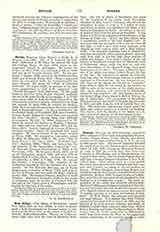

NEW ABBEY—The Abbey of Sweetheart, named New Abbey Pow, or New Abbey, in order to distinguish it from Dundrennan in the same county, is situated near the River Pow, in the parish of Loch Kenderloch, Kirkcudbrightshire, Diocese of Galloway, about eight miles from the town of Dumfries, Scotland. The title of Abbey of Sweetheart was given by the foundress of the abbey, Lady Devorgilla, daughter of Alan, Lord of Galloway, who erected the monastery in order to keep in it a casket of ivory and silver, in which was embalmed the heart of her husband, King John de Baliol. Sweetheart is the last in order of the Cistercian abbeys in Scotland. It was begun in 1275, being a daughter of Dundrennan, of the lineage of Clairvaux. Henry, the first abbot, built a magnificent church in the early English style. It measured 203 feet in length, with a central tower 92 feet high; it had a nave with aisles, transepts with chapels on their eastern sides, and a choir without aisles. The monastic buildings were in proportion, and were surrounded with a massive granite enclosing wall, from eight to ten feet high, large portions of which still remain. Very little is known of the old history of Sweetheart, except that the Maxwells, lords of Kirkconnel, whose castle was near by, and who were descendants of the Maxwell kings, were great benefactors of the place. The most celebrated superior of the abbey was Abbot Gilbert Broun, the last of the line. He continued to uphold the Catholic faith long after the Reformation, and was a powerful opponent of Protestantism. He was denounced several times on the charge of enticing to “papistrie” from 1578 to 1605; he was seized by his enemies in 1605 in spite of the resistance of the whole countryside, taken prisoner, and conveyed to Edinburgh, whence he was banished. He then became rector of the Scots College, Paris, where he died in 1612 at the age of eighty-four. The possessions of Sweetheart Abbey passed into the hands of Sir John Spottiswoode in 1624, and with them the title of Lord of New Abbey. The monastery soon became a mere quarry for those who wanted ready-cut material for building. The chapter, with the remains of the library over it, and a part of the church, are all that remain today.
EDMOND M. OBRECHT

